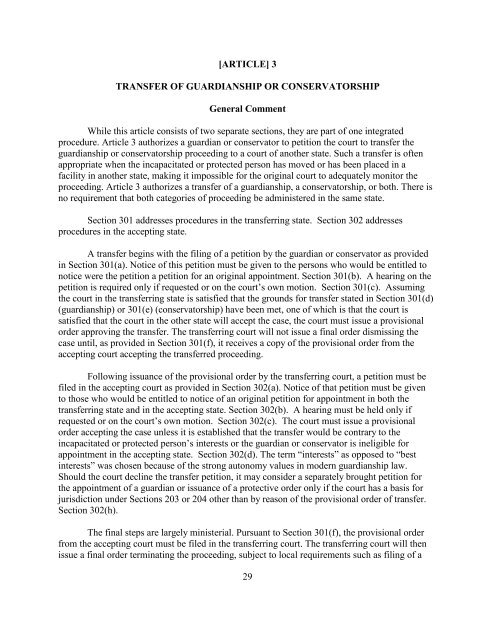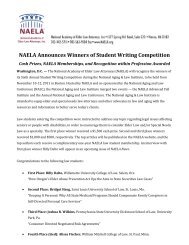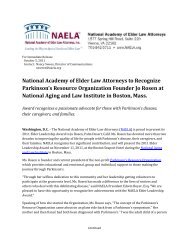uniform adult guardianship and protective proceedings jurisdiction act
uniform adult guardianship and protective proceedings jurisdiction act
uniform adult guardianship and protective proceedings jurisdiction act
Create successful ePaper yourself
Turn your PDF publications into a flip-book with our unique Google optimized e-Paper software.
[ARTICLE] 3TRANSFER OF GUARDIANSHIP OR CONSERVATORSHIPGeneral CommentWhile this article consists of two separate sections, they are part of one integratedprocedure. Article 3 authorizes a guardian or conservator to petition the court to transfer the<strong>guardianship</strong> or conservatorship proceeding to a court of another state. Such a transfer is oftenappropriate when the incapacitated or protected person has moved or has been placed in afacility in another state, making it impossible for the original court to adequately monitor theproceeding. Article 3 authorizes a transfer of a <strong>guardianship</strong>, a conservatorship, or both. There isno requirement that both categories of proceeding be administered in the same state.Section 301 addresses procedures in the transferring state. Section 302 addressesprocedures in the accepting state.A transfer begins with the filing of a petition by the guardian or conservator as providedin Section 301(a). Notice of this petition must be given to the persons who would be entitled tonotice were the petition a petition for an original appointment. Section 301(b). A hearing on thepetition is required only if requested or on the court’s own motion. Section 301(c). Assumingthe court in the transferring state is satisfied that the grounds for transfer stated in Section 301(d)(<strong>guardianship</strong>) or 301(e) (conservatorship) have been met, one of which is that the court issatisfied that the court in the other state will accept the case, the court must issue a provisionalorder approving the transfer. The transferring court will not issue a final order dismissing thecase until, as provided in Section 301(f), it receives a copy of the provisional order from theaccepting court accepting the transferred proceeding.Following issuance of the provisional order by the transferring court, a petition must befiled in the accepting court as provided in Section 302(a). Notice of that petition must be givento those who would be entitled to notice of an original petition for appointment in both thetransferring state <strong>and</strong> in the accepting state. Section 302(b). A hearing must be held only ifrequested or on the court’s own motion. Section 302(c). The court must issue a provisionalorder accepting the case unless it is established that the transfer would be contrary to theincapacitated or protected person’s interests or the guardian or conservator is ineligible forappointment in the accepting state. Section 302(d). The term “interests” as opposed to “bestinterests” was chosen because of the strong autonomy values in modern <strong>guardianship</strong> law.Should the court decline the transfer petition, it may consider a separately brought petition forthe appointment of a guardian or issuance of a <strong>protective</strong> order only if the court has a basis for<strong>jurisdiction</strong> under Sections 203 or 204 other than by reason of the provisional order of transfer.Section 302(h).The final steps are largely ministerial. Pursuant to Section 301(f), the provisional orderfrom the accepting court must be filed in the transferring court. The transferring court will thenissue a final order terminating the proceeding, subject to local requirements such as filing of a29










